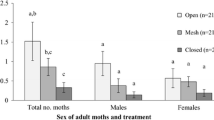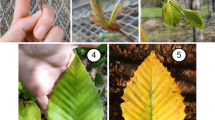Abstract
Volatile chemicals produced by plants mediate host location, mate-finding and oviposition behavior in insects. State-dependent response to plant cues allows for timing of foraging, mating and oviposition on ephemeral host plants or plant parts. Caloptilia fraxinella is a herbivorous specialist on the foliage of ash trees (Fraxinus). Adults are long-lived and undergo a nine-month reproductive diapause over the fall and winter. Mating and oviposition occur in the spring when volatile chemicals released by ash leaves mediate host location. This study tested the plasticity of olfactory response of C. fraxinella to host plant volatiles using both electroantennogram and behavioral bioassays. The effect of moth physiological state on olfactory response was tested on male and female moths in different nutritional, mating, and diapause states. Antennal responses to host plant volatiles were plastic and depended on moth physiological state, and were highest when moths were reproductively active and would be seeking oviposition hosts. Moth sex and nutritional status also impacted antennal response to host plant volatiles. Oriented flight of females to ash seedlings varied with physiological state and nutritional status, with fed, reproductively active females having the highest response. Physiological state impacted oriented flight of males to female-produced sex pheromone signals whether or not a host plant was present, and there was no increase in behavioral response to sex pheromone in the presence of an ash host.







Similar content being viewed by others
References
Anderson P, Sadek MM, Larsson M, Hansson BS, Thöming G (2013) Larval host plant experience modulates both mate finding and oviposition choice in a moth. Anim Behav 85:1169–1175
Anesbo L, Coracini MDA, Bengtsson M, Liblikas I, Ramirez M, Borg-Karlson A-K, Tasin M, Witzgall P (2004) Antennal and behavioural response of codling moth Cydia pomonella to plant volatiles. J Appl Entomol 128:488–493
Anton S, Dufour M-C, Gadenne C (2007) Plasticity of olfactory-guided behaviour and its neurobiological basis: lessons from moths and locusts. Entomol Exp Appl 123:1–11
Barker JF, Herman WS (1976) Effect of photoperiod and temperature on reproduction of the monarch butterfly, Danaus plexippus. J Insect Physiol 22:1565–1568
Browne LB (1993) Physiologically induced changes in resource-oriented behavior. Annu Rev Entomol 38:1–35
Bruce TJA, Pickett JA (2011) Perception of plant volatile blends by herbivorous insects – finding the right mix. Phytochemistry 72:1605–1611
Burrows M, Morawo T, Fadamiro H (2017) Sugar diet affects odor reception but variation in sugar concentration plays minimal role in the response of the parasitoid, Microplitis croceipes (hymenoptera: Braconidae), to host-related plant volatiles. J Econ Entomol 110:971–977
Cusson M, Yagi KJ, Tobe SS, McNeil JN (1993) Identification of release products of corpora allata of male and female armyworm moths, Pseudaletia unipuncta. J Insect Physiol 39:775–783
Davis EE (1984) Development of lactic acid-receptor sensitivity on host-seeking behaviour in newly emerged female Aedes aegypti mosquitoes. J Insect Physiol 30:211–215
Deisig N, Kropf J, Vitecek S, Pevergne D, Rouyar A, Sandoz J-C, Lucan P, Gadenne C, Anton S, Barrozo R (2012) Differential interactions of sex pheromone and plant odour in the olfactory pathway of a male moth. PLoS One 7:1–11
Deng J-Y, Wei H-Y, Huang Y-P, Du J-W (2004) Enhancement of attraction to sex pheromones of Spodoptera exigua by volatile compounds produced by host plants. J Chem Ecol 30:2037–2045
Denlinger DL (2002) Regulation of diapause. Annu Rev Entomol 47:93–122
Evenden ML (2009) Biology of Caloptilia fraxinella (Lepidoptera: Gracillariidae) on ornamental green ash, Fraxinus pennsylvanica (Oleaceae). Can Entomol 141:31–39
Evenden ML, Gries R (2008) Plasticity of male response to sex pheromone depends on physiological state in a long-lived moth. Anim Behav 75:663–672
Evenden ML, Armitage G, Lau R (2007) Effects of nutrition and methoprene treatment upon reproductive diapause in Caloptilia fraxinella (Lepidoptera: Gracillariidae). Physiol Entomol 32:275–282
Gadenne C, Barrozo RB, Anton S (2016) Plasticity in insect olfaction: to smell or not to smell? Annu Rev Entomol 61:317–333
Grosmaitre X, Marion-Poll F, Renou M (2011) Biogenic amines modulate receptor neurons firing activity in Mamestra brassicae. Chem Senses 26:653–661
Hansson BS (1995) Olfaction in Lepidoptera. Experientia 51:1003–1027
Hespenheide HA (1991) Bionomics of leaf-mining insects. Annu Rev Entomol 36:535–560
Horton DR, Capinera JL (1988) Effects of host availability on diapause and voltinism in a non-agricultural population of Colorado potato beetle (Coleoptera: Chrysomelidae). J Kansas Entomol Soc 61:62–67
Hunter M, McNeil JN (1997) Host-plant quality influences diapause and voltinism in a polyphagous insect herbivore. Ecology 78:977–986
Klowden MJ, Lea AO (1979) Humoral inhibition of host-seeking in Aedes aegypti during oocyte maturation. J Insect Physiol 25:231–235
Landolt PJ, Phillips TW (1997) Host plant influences on sex pheromone behavior of phytophagous insects. Annu Rev Entomol 42:371–391
Lemmen JK, Evenden ML (2009) Peripheral and behavioral plasticity of pheromone response and its hormonal control in a long-lived moth. J Exp Biol 212:2000–2006
Lemmen JK, Evenden ML (2015) Environmental conditions terminate reproductive diapause and influence pheromone perception in the long-lived moth, Caloptilia fraxinella. Physiol Entomol 40:30–42
Lemmen JK, Evenden ML (2016) The roles of juvenile hormone and biogenic amines on pheromone response plasticity and diapause termination in male Caloptilia fraxinella. Entomol Exp Appl 158:184–201
Light DM, Flath RA, Buttery RG, Zalom FG, Rice RE, Dickens JC, Jang EB (1993) Host-plant green-leaf volatiles synergize the synthetic sex pheromones of the corn earworm and codling moth (Lepidoptera). Chemoecology 4:145–152
Marchioro CA, Foerster LA (2013) Effects of adult-derived carbohydrates and amino acids on the reproduction of Plutella xylostella. Physiol Entomol 38:13–19
Martel V, Anderson P, Hansson BS, Schlyter F (2009) Peripheral modulation of olfaction by physiological state in the Egyptian leaf worm Spodoptera littoralis (Lepidoptera: Noctuidae). J Insect Physiol 55:793–797
Mechaber WL, Capaldo CT, Hildebrand JG (2002) Behavioral responses of adult tobacco hornworms, Manduca sexta, to hostplant volatiles change with age and mating status. J Insect Sci 2:1–8
Ohgushi T (2016) Eco-evolutionary dynamics of plant-herbivore communities: incorporating plant phenotypic plasticity. Curr Opin Insect Sci 14:40–45
Pivnick KA, Jarvis BJ, Gillott C, Slater GP, Underhill EW (1990) Daily patterns of reproductive activity and the influence of adult density and exposure to host plants on reproduction in the diamondback moth (Lepidoptera: Plutellidae). Environ Entomol 19:587–593
Pohl GR, Saunders C, Barr WB, Wartenbe MD, Fownes SL (2004) Caloptilia fraxinella (Lepidoptera: Gracillariidae), a new pest of ash (Oleaceae: Fraxinus spp.) on the Canadian prairies. Can Entomol 136:733–736
Pophof B (2000) Octopamine modulates the sensitivity of silkmoth pheromone receptor neurons. J Comp Physiol A 186:307–313
Pophof B (2002) Octopamine enhances moth olfactory responses to pheromones, but not those to general odorants. J Comp Physiol A 188:659–662
R Development Core Team (2012) R: a language and environment for statistical computing. R Foundation for Statistical Computing, Vienna, Austria. isbn:3-900051-07-0 http://www.R-project.org/
Ramaswamy SB, Shu S, Park YI, Zeng F (1997) Dynamics of juvenile hormone-mediated gonadotropism in the Lepidoptera. Arch Insect Biochem Physiol 35:539–558
Reisenman CE, Riffell JA (2015) The neural bases of host plant selection in a neurobiology framework. Front Physiol 6:229
Saveer AM, Kromann SH, Birgersson G, Bengtsson M, Lindblom T, Balkenius A, Hansson BS, Witzgall P, Becher PG, Ignell R (2012) Floral to green: mating switches moth olfactory coding and preference. Proc R Soc B 279:2314–2322
Schmidt-Büsser D, von Arx M, Guerin PM (2009) Host plant volatiles serve to increase the response of male European grape berry moths, Eupoecilia ambiguella, to their sex pheromone. J Comp Physiol A 195:853–864
Schmidt-Busser D, von Arx M, Connetable S, Guerin PM (2011) Identification of host-plant chemical stimuli for the European grape berry moth Eupoecilia ambiguella. Physiol Entomol 36:101–110
Shu S, Grant GG, Langevin D, Lombardo DA, MacDonald L (1997) Oviposition and electroantennogram responses of Dioryctria abietivorella (Lepidoptera: Pyralidae) elicited by monoterpenes and enantiomers from eastern with pine. J Chem Ecol 23:35–50
Sole J, Sans A, Riba M, Guerrero A (2010) Behavioural and electrophysiological responses of the European corn borer Ostrinia nubilalis to host-plant volatiles and related chemicals. Physiol Entomol 35:354–363
Tran B, Huignard J (1992) Interactions between photoperiod and food affect the termination of reproductive diapause in Bruchus rufimanus (Boh.), (Coleoptera, Bruchidae). J Insect Physiol 38:633–642
Varela N, Avilla J, Gemeno C, Anton S (2011) Ordinary glomeruli in the antennal lobe of male and female tortricid moth Grapholita molesta (Busck) (Lepidoptera: Tortricidae) process sex pheromone and host-plant volatiles. J Exp Biol 214:637–645
Von Arx M, Schmidt-Busser D, Guerin PM (2012) Plant volatiles enhance behavioral responses of grapevine moth males, Lobesia botrana to sex pheromone. J Chem Ecol 38:222–225
Wheeler D (1996) The role of nourishment in oogenesis. Annu Rev Entomol 41:407–431
Wist TJ (2014) Semiochemical-mediated interactions of an invasive leaf miner, Caloptilia fraxinella (Lepidoptera: Gracillariidae), on a non-native host, Fraxinus spp. (Oleaceae) and its native parasitoid, Apanteles polychrosidis (hymenoptera: Braconidae). Dissertation, university of Alberta
Wist TJ, Evenden ML (2016) Host plant preference and offspring performance of a leaf-mining moth, Caloptilia fraxinella (Lepidoptera: Gracillariidae) on two Fraxinus species. Entomol Exp Appl 159:311–326
Wist TJ, Gries R, Evenden ML (2014) The use of plant volatiles for host location by an ash specialist, Caloptilia fraxinella. Chemoecology 24:229–242
Yan F, Bengtsson M, Witzgall P (1999) Behavioral response of female codling moths, Cydia pomonella, to apple volatiles. J Chem Ecol 25:1343–1351
Yang Z, Bengtsson M, Witzgall P (2004) Host plant volatiles synergize response to sex pheromone in codling moth, Cydia pomonella. J Chem Ecol 30:619–629
Acknowledgements
We would like to thank members of the Evenden laboratory at the University of Alberta for their assistance with insect collection and laboratory bioassays. Thankyou to Dr. Wilbert Ronald and Jeffries Nurseries of Portage la Prairie, Manitoba for donating the ash seedlings. This study was financially supported by the Alberta Crop Industry Fund and a NSERC Discovery Grant (M.L.E.). Student support was provided by the Department of Biological Sciences, University of Alberta, and through scholarships from Alberta Innovates (T.W.) and NSERC-PGS-D3 to J.L. and T.W.
Author information
Authors and Affiliations
Corresponding author
Electronic supplementary material
ESM 1
(DOCX 22 kb)
Rights and permissions
About this article
Cite this article
Lemmen-Lechelt, J.K., Wist, T.J. & Evenden, M.L. State-Dependent Plasticity in Response to Host-Plant Volatiles in a Long-Lived Moth, Caloptilia fraxinella (Lepidoptera: Gracillariidae). J Chem Ecol 44, 276–287 (2018). https://doi.org/10.1007/s10886-018-0927-3
Received:
Revised:
Accepted:
Published:
Issue Date:
DOI: https://doi.org/10.1007/s10886-018-0927-3




